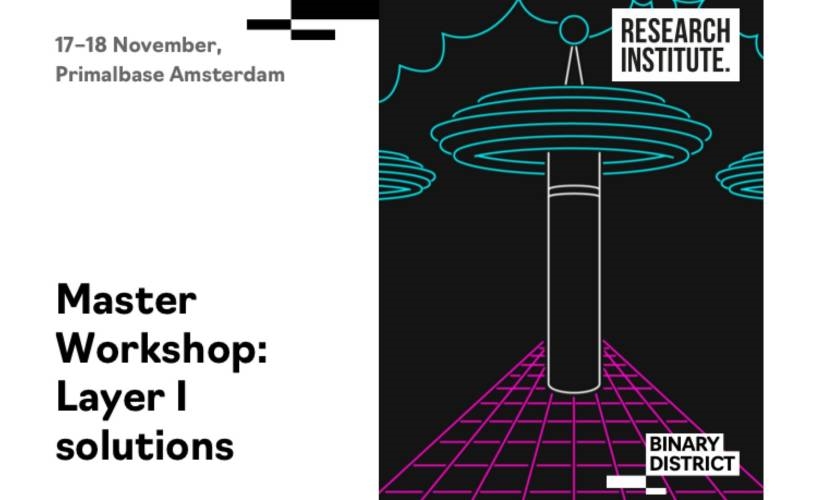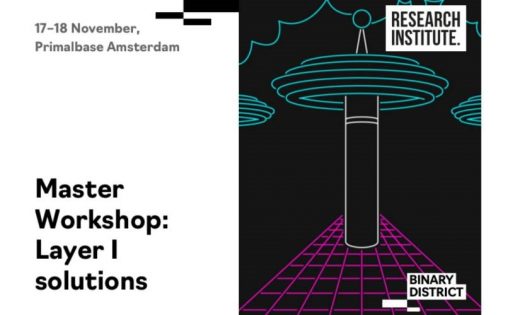Blockchain Scalability: Even If Most Transactions Are in Layer II We Still Need a Layer I
Blockchain Scalability: Even If Most Transactions Are in Layer II We Still Need a Layer I

Space is filling up at Master Workshop: Layer I, where 20+ of the world’s foremost experts on blockchain will present and lead discussions around solutions to the technology’s scalability problem. Don’t forget to register today for free!
The most pressing obstacle to blockchain’s march to mass-adoption is its scalability, or current lack thereof. For blockchain to be genuinely useful, it has to cater to the population at scale and provide a fast, functional alternative to traditional transfers. So, when you consider that Bitcoin currently averages around 7 transactions per second (tps) to VISA’s 2000 or PayPal’s 200, the scope for improvement necessary becomes clear.
There are numerous different groups now working to find a solution. These fall into two schools of thought. There are those that believe transactions should, as far as possible, all take place on chain, and there are those that see layer II solutions as the only viable way of scaling blockchain out.
Keeping it On Chain
There are clear and important advantages to keeping transactions on-chain. What layer I generally means is that the entire blockchain is modified periodically to reflect all transactions, with each one logged in finite blocks across every node in the network. Each transaction is ratified by a set number of participants in the chain, then recorded on a block which is dispersed across all nodes – complete immutability.
Some view layer I solutions as the only way of sticking to blockchain’s ‘true’ principles of full transparency and intrinsic security. Others, though, see this transparency as problematic in and of itself, and argue that full security can be achieved off chain. On-chain transfers also take a significant amount longer to process given the different steps necessary in making them happen.
Utilizing Off-Chain Solutions
Layer II solutions go a long way to solving blockchain’s fundamental issues. Ultimately, the thinking is that not every small transaction necessarily has to take place on the chain, rather the chain can be regularly updated to reflect balances. Taking transactions away from the main blockchain alleviates the stress on it.
“Why would you need the mediator if you are actually in accordance with each other?”
In this case, the blockchain acts as a mediator. It does not actually need to be used unless two parties disagree with each other. Arthur Gervais, assistant professor at Imperial College London and co-founder of off-chain solution Liquidity.Network explained the thinking behind off-chain solutions to Inverse. “Why would you need the mediator if you are actually in accordance with each other?” he says.
“It’s very similar to having a purse on you,” he continues. “Do you carry a whole bank account there? No, you don’t. A fraction of your wealth that you own, you have in your purse, and this is used for everyday transactions. You’re not making a bank transfer every time you’re paying for coffee.”
Off-chain solutions can speed up the blockchain, taking cumbersome transactions away from the primary chain and reducing transaction costs by extension. It is currently unclear whether it is possible at all to scale blockchain without using some form of off-chain solution. In fact, it is unclear whether it will be possible without a combination of a number of different off-chain solutions working together to keep the main chain ticking over.
A Compromise is Needed
Both have their positives and their drawbacks. Increasingly, though, those working on scalability acknowledge that a combination of both is likely the only way forward for blockchain.
“Without layer II scaling solutions, there’s only so much that you can scale on-chain, fundamentally. Without layer I scaling solutions, there is a limit to how many channels you can open and close on-chain.”
Binary District Journal spoke to Mustafa Al-Bassam, PhD researcher in computer security at UCL and co-founder of blockchain platform Chainspace. To Mustafa, there is no realistic future for blockchain that doesn’t include both layer I and layer II solutions. “I think, fundamentally, you need both. You need both layers I and II. Without layer II scaling solutions, there’s only so much that you can scale on-chain, fundamentally. Without layer I scaling solutions, there is a limit to how many channels you can open and close on-chain.”
It’s important that we aren’t put off by the complexity of combining both layer I and layer II solutions. It’s also vital that solutions aren’t discarded because they are initially cumbersome in their complexity.
“In the development of blockchain, there can be a lot of complexities and challenges involved,” Mustafa says. “For example, proof-of-stake can be a lot more complex than proof-of-work, or sharding is fundamentally more complex than not doing sharding. I think people often mistake that as something that’s bad–just because something is complicated, it must then be wrong. I don’t think that’s necessarily the case.”
One of the key arguments for layer II solutions is that not every transaction needs to be logged for all to see on the main chain. There are privacy concerns – not everyone wants their financial history broadcast across a vast network – and there are speed issues that cannot be justified.
“All current layer II solutions require the client to watch the blockchain all the time in order to make sure he is not cheated.”
Lefteris Kokoris Kogias, cryptocurrency expert and PhD researcher at EPFL, echoes Mustafa’s position, understanding that while on chain solutions are more secure, there is a realistic necessity for off-chain. “Layer I and layer II solutions are both needed,” he explains. “Having to globally announce that you spend 5$ at Starbucks might be an overkill, but even if most transactions are in layer II we still need a layer I with good capacity to handle settlement and dispute.
“The advantage of on-chain solutions is that they are a lot harder to break. For example, all current layer II solutions require the client to watch the blockchain all the time in order to make sure he is not cheated.”
A Focus on UX Could Be the Key
We also spoke with PhD researcher at UCL, Sarah Azouvi. For Sarah, the combination of layer I and layer II solutions is possible only if a functional UX can be developed to facilitate it. “Both layer I and layer II solutions are interesting lines of research to solve blockchains’ scalability problem,” Sarah says. “I do see layer I solving the issue as there are a lot of inherent problems with layer II solutions, such as keys management, routing or multiplayer channels.
“With layer I solutions, the scalability is solved within the protocol, there is no additional burden for the users.”
“In layer II solutions, the ‘complexity’ is sometimes transferred to the user side (for example some solutions proposed imply a heavy key management for the user). This is quite inconvenient as blockchains already have some UX problems, layer II solutions magnify this problem. With layer I solutions, the scalability is solved within the protocol, there is no additional burden for the users (of course this still depends on how the solution is implemented).”
Layer I solutions are said by some to be the only way of achieving a truly democratic blockchain, in which all transactions are visible and properly ratified by an appropriate number of agents. They also, in theory, remove the need for the third-parties that are sometimes used in off-chain solutions. We put this to Sarah, who believes it is a lot more complex than that.
“Collaboration has always been one of blockchain’s strongest assets, and going forward, even slightly opposing ideologies will have to combine.”
“It’s hard to define what you mean by a ‘truly democratic blockchain’,” she says, “but I don’t think that layer I solution will solve any of this since you would still need Sybil resistant mechanism (like proof-of-work or proof-of-stake) to ensure security, thus preventing from a one person one vote blockchain. The solution to one person one vote blockchain lies somewhere else.”
Ultimately, there seems to be a consensus among the majority of the community that utilizing both layer I and layer II solutions is a no-brainer. What exact combination we end up seeing from the myriad solutions being developed is anyone’s guess, but using both offers the security and speed that will help blockchain to scale effectively. Collaboration has always been one of blockchain’s strongest assets, and going forward, even slightly opposing ideologies will have to combine.
Blockchain Scalability Workshop in Amsterdam
The ‘Master Workshop: Layer I Solutions’ event, in Amsterdam 17-18 November, will bring together those working on every corner of layer I scalability. From the DAG-based cryptocurrency framework, to the creation of secure, scalable decentralized ledgers via sharding, the workshop will be a space for the sharing of ideas and the comparison of solutions from expert to expert.
The event will see Sarah, Mustafa and Lefteris speaking alongside more than 15 leading experts from across the blockchain space, including Philipp Jovanovic, Christopher Carr, and Ewa Syta, among others.
No sales pitches, just pure tech. Conversation and collaboration with the best in the business. Don’t miss your chance, register for free today!
The post Blockchain Scalability: Even If Most Transactions Are in Layer II We Still Need a Layer I appeared first on ReadWrite.
(9)


